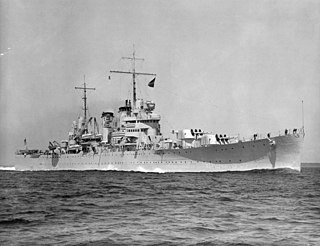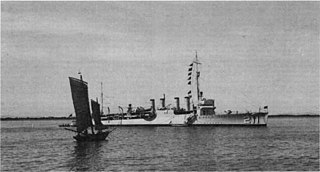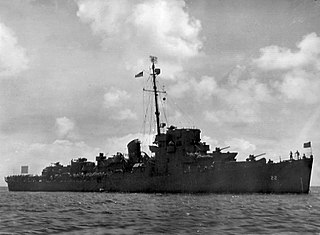
USS Boise (CL-47) was a light cruiser of the Brooklyn class in the United States Navy. The cruiser was named for Boise, the capital city of the state of Idaho. Commissioned in 1938, she saw extensive service during World War II, taking part in fighting in the Mediterranean and Pacific theaters. Following the war the ship was decommissioned in 1946 and lay idle until sold to Argentina in 1951. Renamed ARA Nueve de Julio, the ship remained in service with the Argentinian Navy until 1978, after which she was taken to Brownsville, Texas and scrapped in 1983.

USS Whipple, a Clemson-class destroyer was the second ship of the United States Navy named in honor of Captain Abraham Whipple (1733–1819), who served in the Continental Navy.

USS Schley (DD-103) was a Wickes-class destroyer in the United States Navy during World War I and later designated, APD-14 in World War II. She was the first ship named in honor of Winfield Scott Schley.

USS Taylor (DD/DDE-468) was a Fletcher-class destroyer of the United States Navy, named for Rear Admiral William Rogers Taylor (1811–1889). She was laid down on 28 August 1941 at Bath, Maine, by the Bath Iron Works Corp.; launched on 7 June 1942, sponsored by Mrs. H. A. Baldridge; and commissioned on 28 August 1942 at the Charlestown Navy Yard near Boston, Mass.

USS Alden (DD-211) was a Clemson-class destroyer of the United States Navy (USN). Serving during World War II, Alden is the only ship of the US Navy to have been named for Rear Admiral James Alden, Jr. (1810–1877).

USS Tracy (DD-214/DM-19) was a Clemson-class destroyer in the United States Navy during World War II. She was the only ship named for Secretary of the Navy Benjamin Franklin Tracy.

USS John D. Edwards (DD-216) was a Clemson-class destroyer in the United States Navy during World War II.

USS Parrott (DD-218) was a Clemson-class destroyer in the United States Navy during World War II and was the second ship named for George Fountain Parrott.

USS Bulmer (DD-222/AG-86) was a Clemson-class destroyer in the United States Navy during World War II. It was the last warship of the Asiatic Fleet in USN commission.

USS John D. Ford (DD-228/AG-119) was a Clemson-class destroyer in the United States Navy during World War II. She was named for Rear Admiral John Donaldson Ford.

USS Kane (DD-235/APD-18) was a Clemson-class destroyer in the United States Navy during World War II. She was the first ship named for Elisha Kent Kane.

USS Goff (DD-247) was a United States Navy Clemson-class destroyer in commission from 1921 to 1931 and from 1932 to 1945. She saw service during the Second Nicaraguan Campaign and World War II. She was named for Secretary of the Navy Nathan Goff, Jr.

USS Trinity (AO-13) was a Patoka-class replenishment oiler of the United States Navy.

USS Livermore (DD-429), a Gleaves-class destroyer, was the 1st ship of the United States Navy to be named for Samuel Livermore, the first naval chaplain to be honored with a ship in his name.

USS Kearny (DD-432), a Gleaves-class destroyer, was a United States Navy warship during World War II. She was noted for being torpedoed by a German U-boat in October 1941, before the U.S. had entered the war. She survived that attack, and later served in North Africa and the Mediterranean.

USS Sicard (DD-346/DM-21/AG-100) was a United States Navy Clemson-class destroyer in commission from 1920 to 1945. She was service during World War II. She was named for Rear Admiral Montgomery Sicard.

USS Henley (DD-391), a Bagley-class destroyer, was the 2nd ship of the United States Navy to be named for Captain Robert Henley, an officer in the United States Navy during the Quasi-War with France, the War of 1812 and the Second Barbary War.

USS Jouett (DD-396) was a Somers-class destroyer in the United States Navy. She was named for Rear Admiral James Edward Jouett.

USS Isabel (SP-521), later PY-10, was a yacht in commission in the United States Navy as a destroyer from 1917 to 1920 and as a patrol yacht from 1921 to 1946.

USS Wileman (DE-22) was an Evarts-class destroyer escort constructed for the United States Navy during World War II. It was promptly sent off into the Pacific Ocean to protect convoys and other ships from Japanese submarines and fighter aircraft. At the end of the war, she returned to the United States proudly displaying four battle stars.





















